Hunslet, West Riding of Yorkshire
Up to 1834
Hunslet's earliest workhouse operated in Carr Hall, a house on Hunslet Moor Side, which was hired for the purpose.
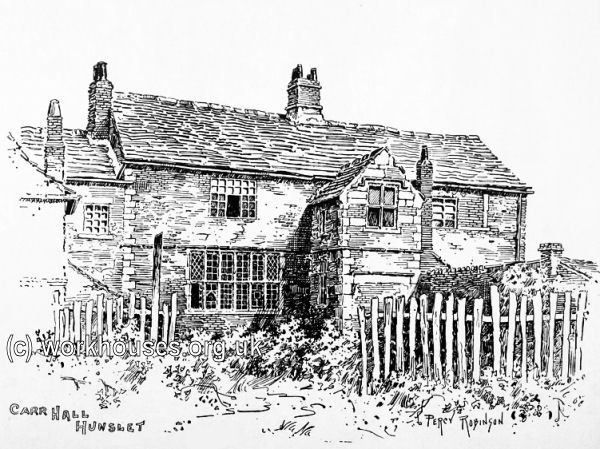
Carr Hall, Hunslet.
In 1760, the Township of Hunslet decided to build a new workhouse. Before this date the Overseers hired a Workhouse for the able-bodied poor, Carr Hall, a house still standing on Hunslet Moor side, is said to have been used for this purpose. However on the 17th March, 1760, a "Meeting of several Proprietors of Land of the Township of Hunslet" was held at the Sign of the Organ (now the Wellington Hotel). Thirteen gentlemen were present and "it was unanimously agreed to erect a Workhouse for the benefit and more convenient relief and employment of the poor." The entry in the old minute book, in the possession of the Guardians, goes on to say that "several plans being produced for the said purpose one was pitched upon and jointly approved by Charles Brandling and Joseph Bilton, Esquires, Lords of the Manor, who were generously disposed to grant a piece of land and to make a free gift of all bricks towards completing the said building." The building does not appear to have cost much money. It was "finished under the care and by the direction of Mr. Richard Markham and Mr. Thos. Bradley," and they appear to have paid the Bricklayers, Robert Fenteman and Allen Longley £62; Thomas Proctor, the Joiner £78; and Wrigglesworth, the Stone Cutter, £42.
The House was opened on May Day, 1761, and at a meeting held on 28th April, among the provisions ordered to be purchased were ten 12- gallon casks of beer, of Mr Arthington. Afterwards, beer was brewed on the premises, as an "iron pott for brewing and washing" was ordered to be purchased.
In answer to an advertisement in the "Leeds Intelligencer," William Matthews was appointed Master of the House at a salary of £12 per annum, to be increased by forty shillings if he proved satisfactory. He was allowed to "bring his wife into the House at bed and board, in consideration of which she is to act as Mistress of the House and to overlook the brewings, washings, and keep all decent and in order in the kitchen."
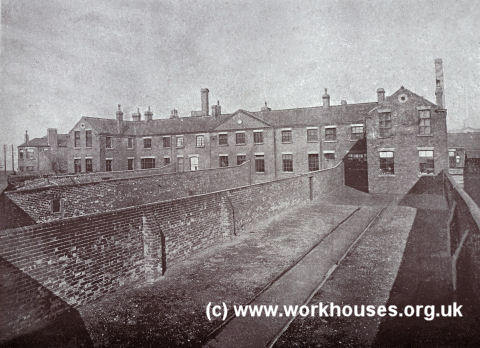
Hunslet old workhouse from the south, c.1903.
© Peter Higginbotham.
The new buildig could house up to forty-five inmates. Initially, twenty-six people were admitted: five men, twelve women and nine children. In addition to these, there were eleven out pensioners, who appear to have received from two to five shillings a month as relief.
The diet ordered by the Trustees was a fairly generous one. Below is the diet in force at Hunslet in 1761, together with the one in operation at the Leeds Workhouse in 1788, for comparison.
| HUNSLET WORKHOUSE DIETARY, 1761. | |||
|---|---|---|---|
| To Breakfast. | To Dinner. | To Supper. | |
| Fryday | Milk porridge | Pudding or dumplins with treakle sauce, with a small piece of bread and butter, or occasionally a pye of broaken meat. | Milk porridge |
| Saturday | Milk porridge | Drink porridge and bread | Milk porridge |
| Sunday | Milk porridge | Boyld beef or mutton with bread and beer, pottatoes or greens, broth served first. | Broth |
| Monday | Broth or milk porridge | Rice milk and broaken meat with drink. | Milk porridge |
| Tuesday | Milk porridge | Bread, cheese, and drink. N.B.—Instead of the above, two calves' hearts, boyld with two pounds bacon. | Milk porridge |
| Wednesday | Milk porridge | Dumplins with sauce and old milk. | Milk porridge |
| Thursday | Water porridge | Beef or mutton, boyled with pottatoes or greens. | Milk porridge |
| LEEDS WORKHOUSE DIETARY, JANUARY 6TH, 1788. | |||
|---|---|---|---|
| Breakfast | Every day | Milk pottage and bread. | |
| Dinner | Sunday | Mutton and broth, bread and beer. | |
| Monday | Rice milk, bread and beer. | ||
| Tuesday | Dumplings and beer. | ||
| Wednesday | Bread, cheese and beer. | ||
| Thursday | Beef and broth, bread and beer. | ||
| Friday | Rice milk, bread and beer. | ||
| Saturday | Drink pottage and bread. | ||
| Supper | Sunday and Thursday | Bread and broth, or broth and beer. | |
| Other days | Milk pottage and bread. | ||
The proportion of bread for each meal is—One wheat cake, weight 3 lbs., divided into eight parts, viz.:—two of 7 oz. for men, four of 6 oz. for women, and two of 5 oz. for children.
| The proportion of flesh meat is 16 lbs. of beef or mutton for 20 persons on an average. | ||
| Ditto. | 1 lb. of rice and 10 oz. of sugar, with pimento, salt, and flour for 20 persons on an average. | |
| Ditto. | 14 oz. of paste each dumpling for adults and 8 oz. for children. | |
| Ditto. | One gallon of milk for pottage for 20 persons. | |
| Ditto. | One-third of a quart (ale measure) of beer at each dinner (Saturday excepted). | |
| Ditto. | 6 oz. of cheese for adults and 4 oz. for children. With full liberty to adults to exchange their portion of beer for bread, or bread for beer. | |
The Leeds Workhouse, on the above date, had 152 inmates, viz.—49 men, 65 women, and 38 boys and girls.
The Committee appointed to govern the Hunslet Workhouse appears to have consisted of eight Trustees, a Provider who was appointed for six months, a Treasurer who was appointed for 12 month, and two Overseers.
Mr. Peacop was the first Provider, and Mr. Stoney was the first Treasurer. The Committee met at three in the afternoon.
The education of the children in the Workhouse had the attention of the Committee at an early date, when an infirm inmate named Susannah Walker appointed to teach the children to read.
Evidently, sheets were in those days not in frequent use in the House, as the Provider is ordered to obtain a couple for the use of the House. Fires could be had for the asking by any sick person in the infirmary, night and morning; in winter, all day. Evidently, the liberal diet allowed by the Committee did not meet with the approval of some of the inmates. It was ordered that if Elizabeth Walker (an old woman of 72) "will not sup no broth of mutton at night it be kept till the next morning for breakfast."
The Trustees appear to have devoted their time at the meetings to giving orders for admission to the House, sending people out, granting cloth and linen for clothes, giving out pensions, and ordering assessments to be made. They do not appear to have attended the meetings very well after the first few months, since resolutions dealing with the non-attendance passed by those present at meetings. The first Master of the House appears to have stayed two years. On account of the bad attendance of Trustees, he appears to have done things which ought to have been done by the Trustees themselves. There are several resolutions recorded defining the Master's duties. "The Master of this House has no power to execute an Indenture on the part of the Township, but may witness an indenture." Again, "That the Master do at all times make a minute in his memorandum book of all such necessaries as may be wanted for the use of the House in order that the gentlemen of the Committee may consider whether they be really useful and wanting, and that the Overseers and Providers do receive orders from the Committee for purchasing the same, and not from the Master of this House."
The Workhouse was evidently not so well built, for the same bricklayer who built the House is ordered to "examine and mend this House" within a year of its building.
A cow is also ordered to be purchased, and the Master ordered to "get a rattan trap made for one shilling."
The Present Board of Guardians pursue a generous policy in regard to granting recommendations to the various Convalescent Homes in the district. Many poor people are sent away each year for the benefit of their health. A hundred and fifty years ago the same generous policy was practiced by the Committee having charge of the old House. The Overseers are ordered to "give Anthony Brook 10/- to send his son to Ilkley Wells, and give him no more pay until the first day of October. Anthony had only 2/- per month from the Overseers; evidently he had to starve whilst his son was being cured.
The following year Brook's son again went to Ilkley Wells, and again the old man's pay was stopped for nearly four months. How he lived in the meantime there is no record.
Dr Bullough was the first Medical Officer to the Poor House. On 29th July, 1762, it was ordered that he "be appointed to attend this House as apothecary and surgeon, and to give medicines or do anything that is needful to any person in this House for which he is to be paid the sum of five pounds." He was re-appointed each year by special resolution. He held office for many years. Nine years after his appointment his salary was raised to eight guineas, but again reduced to five guineas four years later. In 1769, he acted as a Trustee, but he attended the meetings badly. The Overseers, the same year, gave him three pounds ten shillings in order to hire a substitute, as he was drawn for the Militia.
The Overseers were doubtless a very enlightened body of men though perhaps a bit faddy, for the doctor was ordered to "Provide some sea water for the use of this House" What it was to be used for is not stated.
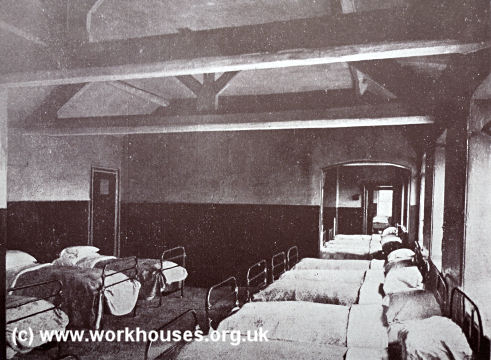
Dormitory in old workhouse, c.1903.
© Peter Higginbotham.
The work provided for the inmates about this time appears to have been spinning and carding wool, weaving woolsey, cropping cloth and grinding corn. Economy evidently was strictly observed, as the Master is ordered at Christmas, 1762, to buy "two pair of tongs at a sale." In September, 1763, an advertisement was inserted in the Intelligencer for a fresh Master, but there is no record as to who was appointed. Probably he was not married, for shortly after Ann Stokes came into the House "to be as Mistress" at three pounds per year.
Gentle compulsion was evidently necessary to get the inmates to Church, as it was found necessary to order that "All people of this House who are able to walk go to some place of protestant publick worship every Sunday or to have no dinner."
The Settlement Acts were strictly administered by the Committee. There are many entries in the Minutes dealing with people who became chargeable and did not belong to the parish, for instance, "Ordered that the Overseers agree with a carrier to convey Sarah Smith and her two children to Liverpool, and find them meat and pay for their passage to Ireland."
"In those days the poor were required to reside in the parish in which they were settled, and change of residence was repressed as much as possible.
Poor persons removing out of one parish into another were liable to be sent back within forty days. They generally fortified themselves with a "certificate" signed by the Overseers and two Magistrates to save inconvenience and annoyance before removing.
Below is a copy of such a certificate issued in 1713 by the Hunslet Overseers.
BURGUS OF LEEDS.
To all whom it may concern, more especially to the Churchwardens and Overseers of the Poor of the Parish of Rothwell, in the West Riding of the County of York.
In pursuance of an Act of Parliament made in the eighth and ninth yeares of the Raigne of our late Soveraigne Lord King William The Third Entituled an Act for Supplying some Defects in the Laws for the Reliefe of the Poore in this Kingdome. These are to Certifie That James Ouldridge, Clothier, had his last lawfull settlement in the Township of Hunslett in the Burrough aforesd. And wee whose names are underwritten Churchwarden and Overseers of the Poor for Hunslett aforesaid doe hereby obleige ourselves and our successors to receive and provide for the said James Ouldridge and Alice his wife and Joseph Ouldridge their son and infant whenever they or any of them shall become chargable to the said Parish of Rothwell, or any other place where they shall happen to inhabitt (provided they shall not acquire a Legall Settlement there) Given under our hands and Seales the 31st day of March Anno Domini 1713.
Witnesses hereof
| WILLIAM KILBURN. | GEORGE ATKINSON. | |
| JOHN CORKHEAD. | CHRISTOPHER GOOD, Chapelwarden. |
Wee whose names are hereunto subscribed two of Her Majesties Justices of the Peace for the aforesaid Burrough of Leeds doe allow of the above written Certificate. Witness our hands the day and yeare above written.
JA KITCHINGMAN
R MITCHELL.
In November, 1769, the Overseers "ordered that Mr Atkinson, Chapelwarden, demand the rent of Aron Akeroyd for the house he now lives in, that was left by Mr. Jno. Brooke for the Poore of Hunslet, and in case he refuse, to make distress according to law." The Overseers were successful in getting rid of "Aron," for at the next meeting Mr. Garnett was asked to "view the house where Aron Akeroyd lately dwelt, and that he bring an estimate of the charge of repairing itt." What has become of this Estate of the poor it would perhaps be difficult to say.
Troublesome people came into the House now and again. There was provided a "chaine and lock to secure Henry Frankland in the stable, and for him to have straw to lye upon." Again, "Sarah Wilkinson earn four pence a day or she is to go without dinner every day." However, Sarah was incorrigible, a month later the Committee ordering that she be given "two shifts, a pair of shoes, a pair of stockings, a petticoat, a woollsey apron, and that she leave the House with her youngest child on Monday morning next." She came into the House four months before this, with two children and had to be sent to the "House of Correction" within a month. "Edward Howden's wife not to have any victuals except she complys with the order of ye Committee to card for Mary Arlin." She did not comply, for at the next meeting of the Committee she, her husband and youngest child, were ignominiously turned out.
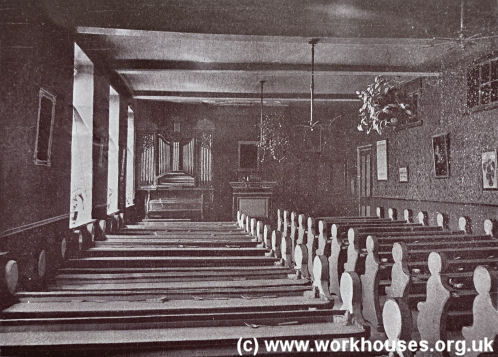
Dining-hall and chapel in old workhouse, c.1903.
© Peter Higginbotham.
Inmates occasionally escaped over the Workhouse wall. The Committee ordered "that if any person or persons go over the wall without consent of the Master or Mistress, that they be not admitted till the following Committee day."
On 28th January, 1768, James Scoles and his wife were appointed Master and Mistress, "upon trial for a few weeks, at eight pounds a year."
In 1769, John Firbis was given twenty shillings and sent to York Infirmary. Why he was sent to York when there was a good Infirmary in Leeds is unclear. John Howard, the great philanthropist who visited Leeds in 1788, said, "This is one of the best hospitals in the Kingdom. In the wards, which are fifteen feet eight inches high, there is great attention to cleanliness, and six circular apertures or ventilators open into a passage five feet and a half wide. There are no fixed testers, no bugs in the beds. Many are here cured of compound fractures, who would lose their limbs in the unventilated and offensive wards of some other hospitals."
The following curious entry appears under the date 19th July, 1770. "Whereas a clock is purchased by the order of the Overseers, belonging to John Walker, the late Clerk of this town, for three pounds three shillings, upon condition that the said clock is returned to James Scales for the said money when he quits this House. Aug. 1st, 1770, James Scales paid to Jno. Atkinson 10/6 towards ye clock. Nov. 22nd paid to Mr Dibb 10/6 towards the clock, by me, James Scales. Paid, the 2nd Feb., 1771, 10/6 to John Atkinson towards ye clock. August 29th, paid for the clock out, £1 11s. 6d., by me, James Scales."
That some supervision was exercised over the accounts is clear from a resolution passed in June 1771. "Thatt the provision bills and casual reliefs be all read over when there is a proper Committee, and also the work done in the House, and that nothing be paid without the order of the Committee."
In August, 1771, there was another change in the staff of the House. James Scales and his wife were given a month's notice to leave, and were given a sum for two bedsteads. It was "aggreed the same day with Aron Copley and his wife to serve at eight pounds a year wages." Three years later this was increased to ten pounds a year.
Another quaint entry on the 12th September, 1771, is "that no Chapelwarden be at any expense for the future about dinners for the Clerk and Dog Wipper upon a Sacrament Sunday. Ordered that the Clerk and Sexton be allowed for the future the salary of two pounds five shillings per annum for doing the whole duty, and that for the future he bring no separate charges in the Chapelwardens' accounts."
The following resolution was passed at a Committee Meeting when Dr. Bullough, who was then a Trustee, was not present. "That if Dolly Crabby cure Mary Atkinson of her fits to the satisfaction of her mother the Overseers shall pay her three shillings." It is to be feared that Dolly did not get her money.
At this date, 1773, the Assessment for the Land Tax of the Township of Hunslet paid to the Crown amounted to £82 5 6
Raised in the Township 85 7 3
----------
Due to the Town 3 1 9
In addition to other industries carried on in the House, corn was grown. There are entries in the month of August in several years, of resolutions passed to sell the corn "upon the Workhouse intacks." A resolution passed in March, 1775, will no doubt commend itself to all, "that the poor of this House have one ounce of tobacco every week."
It was evidently the practice of the Trustees to store the furniture of those people coming into the House who had any. There are several entries in the Minutes having reference to this practice.
Occasionally furniture was sold and the money devoted to the Inmates' maintenance.
That the domestic arrangement of the Master and Mistress did not always meet with the approval of the Trustees as shown by the following.—In February, 1778, it was ordered "that all the beds now in the dining-room be removed upstairs, and that the same be converted into a dining-room for the whole family to dine together; and that Aron Copley and his wife have a bed set up in some part of the same bedroom to lodge in, and that it be immediately put into execution."
The present practice of sending our children out to the Day Schools is evidently an old one, for on the 27th April, 1780, it was ordered "that eight children go to school,"—a great improvement on the then common practice of apprenticing nearly every child coming into the Workhouse.
Again, on October 25th, 1781, six children were ordered to be sent to school.
On the 15th February, 1781, it was ordered "that there be an assessment of seven months for the Relief of the Poor instead of that ordered the first instant for six months, it being found necessary to apply the remaining month toward erecting the wall of the new Burying Ground."
No person was to "have any relief from this Town who keeps a dog or dogs."
On January 3rd, 1782, John Kelsall was appointed Surgeon and Apothecary, salary to be ten pounds a year. At the same meeting a "complaint having been made against Aaron Copley, the Master of the Workhouse, for his bringing a machine for turning yarn and working it for his own benefit, but he having agreed to make a present of it to the Town and to work it in future for the public benefit, it is ordered that he have an allowance of one penny for every shilling to be earned by the said machine over and above his usual wages." "I do hereby agree to the above proposal.—AARON COPLEY."
The Trustees and Overseers do not appear to have attended the Committee Meetings very regularly, on many occasions only one, two, or three members turned up, and there are many occasions when there was no one present except an official. However, on 1st August, 1782, the following resolution was passed, two Trustees and one Overseer being present,—"That the Master of the Workhouse acquaint the Overseers to give their attendance as also the gentlemen of the Committee, or otherwise a publick Town's Meeting will be called upon to look after the business of the Town."
There was a better attendance at the next meeting, but on the 24th October, when only one Overseer and no Trustees turned up, the following entry was made in the minute book. "The Overseers of the Poor request a regular attendance of the Gentlemen of the Committee and Freeholders of the Town, as this day none have attended." Business was transacted as usual.
On the 4th May, 1786, Thomas Furnish was to have 2/6 per year for catching mouldwarps [moles]. In August of the same year there was trouble in the House as to leave. It was ordered "that no person go out of this House on any pretence without a ticket from the Master or Mistress on pain of being discharged this House till the Committee day next following," and also, "that no person make an attempt to go out to any place of worship till ten o'clock in the forenoon nor till two o'clock in the afternoon on Sundays, and to return in due time to their meals or otherwise forfeit them."
In October, 1786, the Committee ordered "a petition to be sined and presented to Mr. Wilberforce, requiring a tax to be laid upon Doges."
In June, 1787, it was ordered "that Jonathan Howton have school wages, paper, ink, pens and paper found by the town."
About this time a wood legg is purchased by the Overseers for John Brough.
In October, 1787, malt is two pounds five shillings a quarter. Malt was bought by the Trustees and given to the poor.
The Trustees and Overseers at their meetings appear to have given relief in money, and also money for rent, besides giving large quantities of Knaresborough cloth for shirts, shifts, etc., coats, clogs, shoes, peticoats, gowns, handkerchiefs, etc., and some were also given their assessment for relief. The times were bad for the poor people apparently, with the same people receiving relief for many years. Many widows came into the House often bringing large families with them. The children were not allowed to stay very long in the House, being put out as apprentices to various people in the district. Six and seven years was a common age for apprenticing, and there is one instance of a child aged two years being put out, although this latter case was simply one of what becae known as boarding out. Apparently the town's people were compelled to take the town apprentices. There are many instances recorded where an unfortunate ratepayer was required to take an apprentice. Even imbeciles were apprenticed but promptly sent back. If a tradesman refused to take one he had to pay ten pounds. Occasionally, a girl was exchanged for a boy and vice versa. In one case three guineas was given with the apprentice besides the usual clothes because he had a tumour under his chin, the Committee agreeing to take the boy back if the "said tumour should prove of bad consequence." Dr Bullough had an apprentice aged 7 years, and a Dr. Billam also had an apprentice put to him.
The administration of the Poor Law must have gone on much the same lines until the great Poor Law Reform Act in 1834, on which modern administration is to a great extent founded.
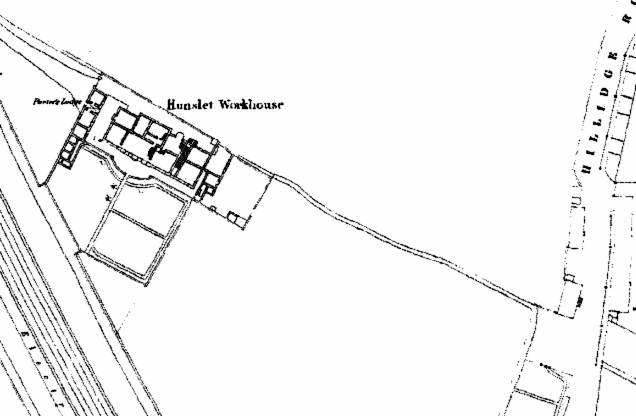
Hunslet Hillidge Road site, 1850.
A parliamentary report of 1777 recorded that the workhouse could accommodate up to 45 inmates.In the same report, Rothwell had a workhouse for up to 200 inmates — this is probably the building erected for the purpose in 1772 on Springfield street. Use of the workhouse was also shared by the townships of Oulton-with-Woodlesford and Lofthouse-with-Carlton.
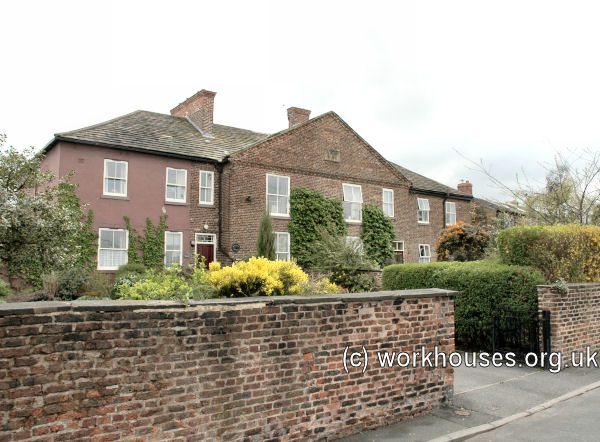
Rothwell parish workhouse, 2005.
© Peter Higginbotham.
In 1812, the Rothwell workhouse was sold off, with Rothwell and Lofthouse-with-Carlton then joining the Carlton Gilbert Union. Oulton-with-Woodlesford then operated its own township workhouse which was located on Quarry Hill, Oulton. The latter closed after the township joined the new Wakefield Union in 1837.
After 1834
There was considerable opposition to the 1834 Poor Law Amendment Act in much of the West Riding. This, coupled with the continuing operation of several Gilbert Unions in the area, meant that the formation of poor law unions in the area took many years. From 1844 until 1862, Hunslet fell within the area administered by the Leeds Guardians. On 29 September 1862, Hunslet was constituted as a separate Poor Law Township, with a 9-strong Board of Guardians. The Hillidge Road workhouse continued in operation. Then, on 21 June 1869, following the abolition of all remaining Gilbert Unions, the Township converted to a Poor Law Union, incorporating several former members of the Carlton Gilbert union. The Hunslet Union was administered by a Board of Guardians, 18 in number, representing its 6 constituent parishes or townships as listed below (figures in brackets indicate numbers of Guardians if more than one):
West Riding of Yorkshire: Hunslet (9), Middleton, Oulton-with-Woodlesford (2), Rothwell (3), Templenewsam (2), Thorpe Stapleton.
The population, in 1861, of the new union was 25,763.
Thorpe Stapleton had previously maintained its own poor, Oulton-with-Woodlesford was previously in the Wakefield Union, Middleton was previously in the dissolved Great Preston Incorporation, and Rothwell and Templenewsam were previously in the dissolved Carlton Incorporation.
Tne new union erected offices at the corner of Glasshouse Street and Leek Street, Hunslet.
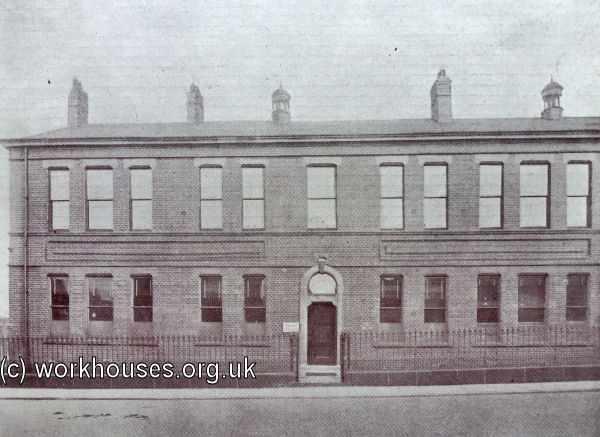
Hunslet union offices from the north-west, c.1903.
© Peter Higginbotham.
The Hillidge Road workhouse was enlarged in around 1867 when a separate Infirmary was added, and again in 1872 when school buildings were erected. After the opening of the cottage homes in 1897 at Rothwell (see below), the school was converted for use as a hospital. Shortly afterwards, the union began work on construction of a new workhouse and infirmary also at Rothwell.
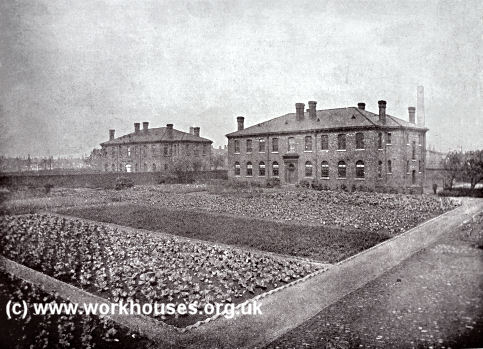
Hunslet old workhouse infirmary from the south, c.1903.
© Peter Higginbotham.
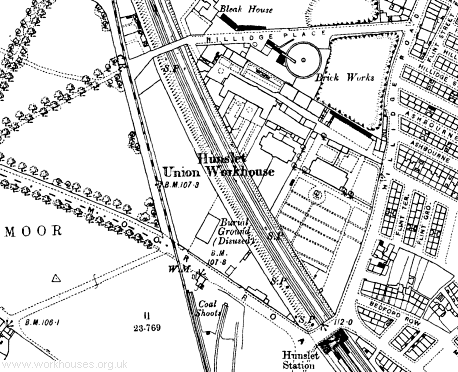
Hunslet Hillidge Road site, 1894.
At the official opening of the new workhouse on the 1st October, 1903, a souvenir programme described the new buildings:
|
THESE buildings have been erected near the junction of Wood Lane and Wakefield Road, at Rothwell Haigh, and the site comprises eighteen and a half acres, which provides ample space for future extension, the present accommodation of the Workhouse and Infirmary being for 450. The administrative portion of the buildings, stores, laundry, boiler house, etc., have been designed large enough for a building twice the size, so it will be seen that the possible need for future extension is well provided for. 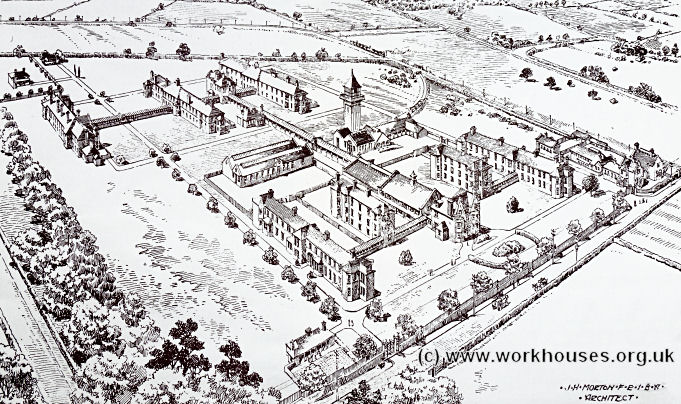
Bird's-eye view of new workhouse, Rothwell Haigh, from the north-east. The buildings consist of six groups viz.:— Entrance Buildings, Main Building, Laundry and Boiler House Building, Infirmary, Lunacy Building, and Isolation Hospital. The entrance building, which is on the right of the principal gates, contains porters' rooms, receiving wards and vagrant wards, where vagrants of both sexes are provided for principally on the cellular system. In this building are also rooms in which to store the inmates' own clothing. The weighbridge is by Messrs. S. Denison and Sons, of Hunslet. 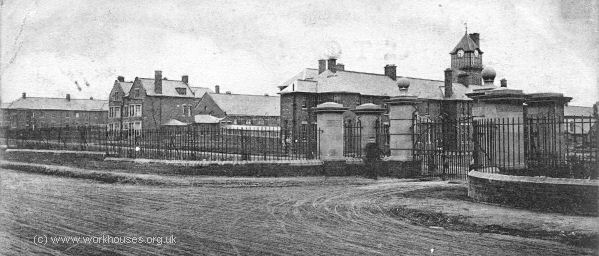
Former workhouse, Rothwell Haigh, from the south-east, 1904. 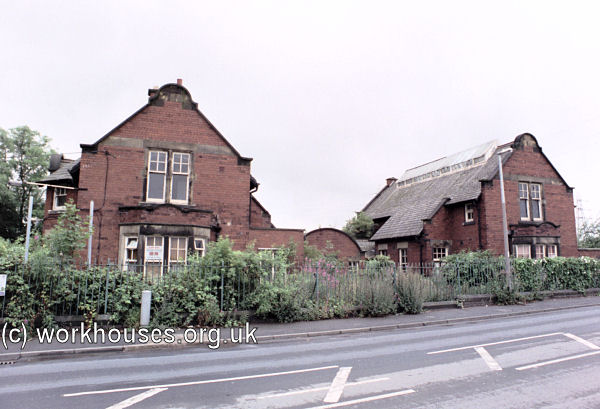
Former workhouse entrance buildings, Rothwell Haigh, from the north, 2001. 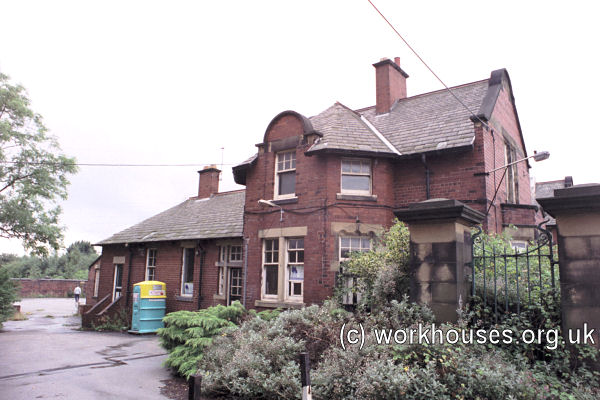
Former workhouse porter's lodge Rothwell Haigh, from the north-east, 2001. The main building or Workhouse proper has the administrative block placed in the centre, in the front of which are the committee room, business offices, and Master's house, and in the rear the dining hall (a handsome apartment with an open timbered roof), kitchen (lighted from the roof and fitted up with all the latest appliances), scullery, work rooms, Matron's office and stores, bakery, and flour stores. Upon each side of the administrative block and connected by glazed observatory corridors are the pavilions for the male and female aged and able-bodied classes, with the necessary day-rooms, officers' rooms, bath rooms, lavatories, and offices. The floors of the entrance hall, kitchen, etc. are in Terazzio. 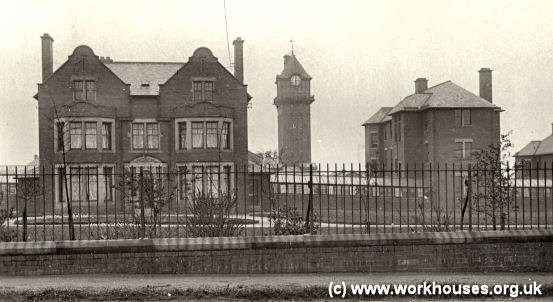
Former Hunslet workhouse master's house (left) and water tower (centre rear), Rothwell Haigh . 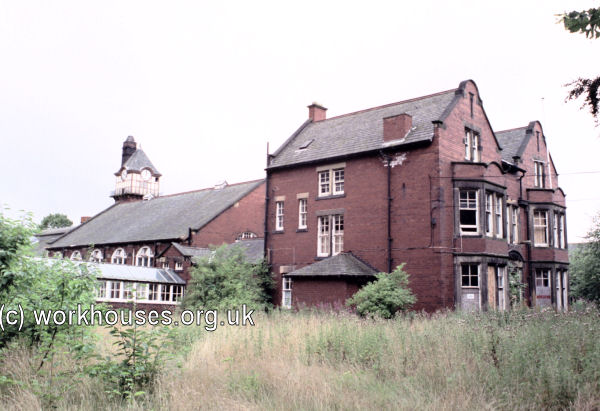
Former workhouse main building, Rothwell Haigh, from the north-east, 2001. 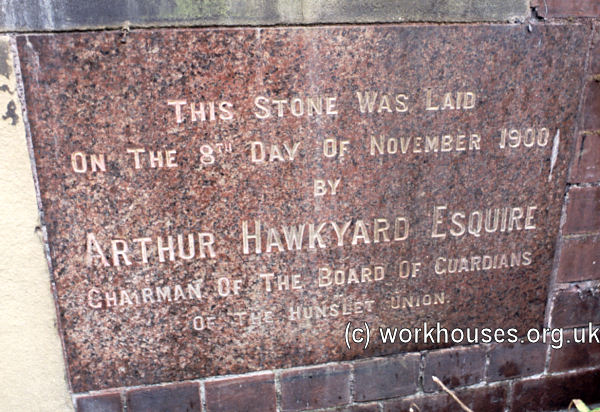
Former Hunslet workhouse foundation stone, Rothwell Haigh, 2001. 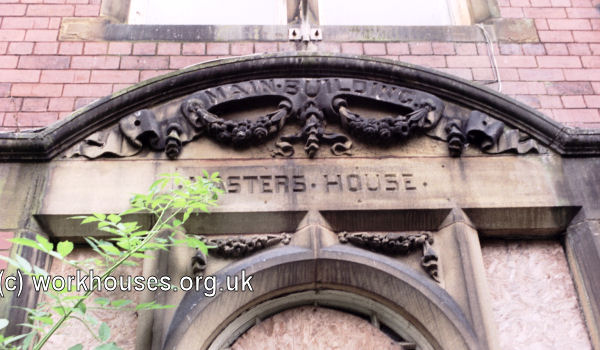
Former Hunslet workhouse main building, Rothwell Haigh, 2001. 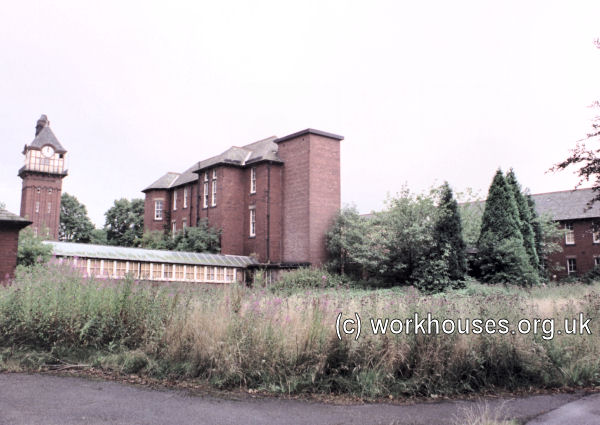
Former Hunslet workhouse blocks for able-bodied (centre) and aged/infirm (right), Rothwell Haigh, from the north-east, 2001. 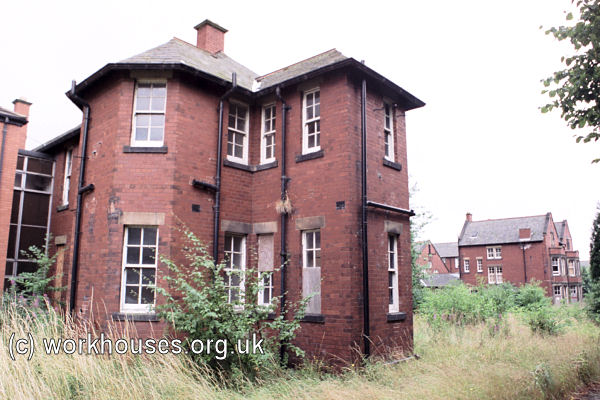
Former Hunslet workhouse aged and infirm block, Rothwell Haigh, from the north-east, 2001. The laundry and boiler house buildings are placed in a central position between the main building and Infirmary. The laundry contains wash house, ironing room, drying room, foul wash house, receiving and distributing rooms, and head laundress' office. 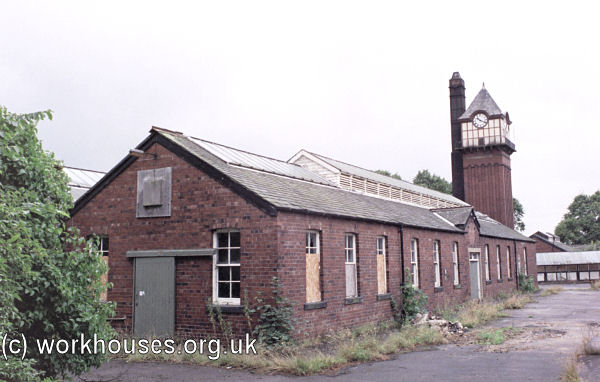
Former Hunslet workhouse laundry block, Rothwell Haigh, 2001. 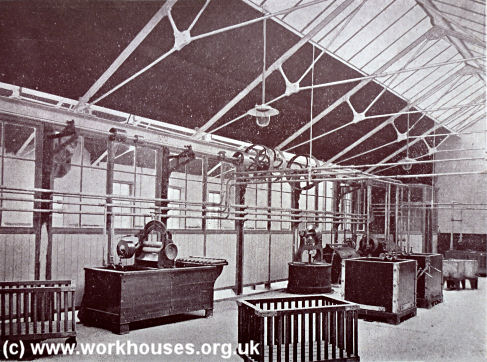
New Hunslet workhouse laundry interior, Rothwell Haigh, c.1903. 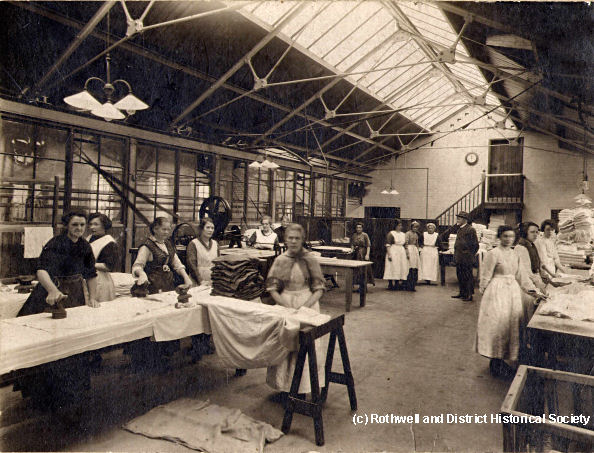
New Hunslet workhouse laundry interior, Rothwell Haigh, date unknown. The boiler house has space for three boilers, and in close proximity to it is the electric light house, with dynamo and accumulator rooms, the workshops, coal house, and water tower. The boilers were made by Messrs. Clayton & Sons, Limited of Hunslet, and are fitted with a Green's patent Coal Economiser and the "Auto" patent Mechanical Stokers. 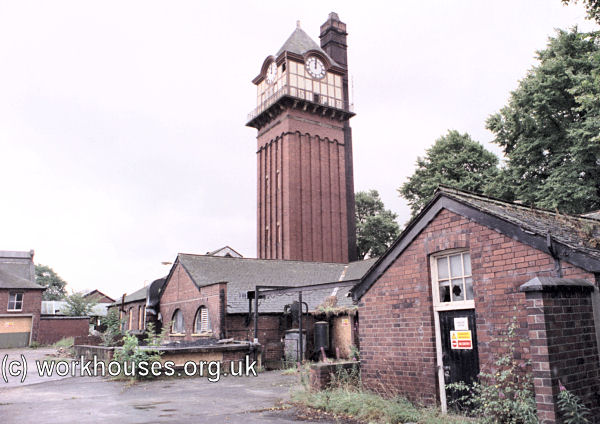
Former Hunslet workhouse boiler-house and water-tower, Rothwell Haigh, from the north-west, 2001. The Infirmary is a complete building in itself and is connected with the main building by a covered corridor from which is entered the central portion of the building, and from this point conservatory corridors to the left and right lead to the male and female pavilions, which pavilions are divided up into wards for the various classes of sick. The nurses' home occupies the central building, and contains nurses' bed, sitting, and recreation rooms, etc., medical officer's room, and dispensary. The front of the Infirmary faces the south, and from it access to large covered balconies at the level of the first and ground floors is possible from all wards. All the walls of the wards are of hard impervious plaster. The lavatories, w.c.'s, etc., are lined with glazed bricks. All the internal angles of walls and between walls and ceilings, walls, and floors, are quadrants. Projections or mouldings are absolutely dispensed with so that there may be no lodgment of dust, and every part of the building may be swept and kept clean. The heating of the large Infirmary wards is by radiators and by means of central Burmantofts Stoves, faced with Faience, with horizontal flues in the thickness of the floors, which are supplied with fresh air direct from the outside. When warm, these flues distribute the heat evenly through the buildings. The floors of the Infirmary wards, as well as the dining hall and other parts of the premises, are polished with "Ronuk" Floor Polish. 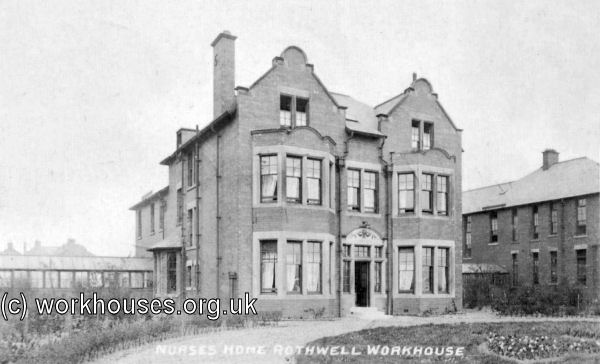
Hunslet workhouse nurses' home from the south-west, c.1910. 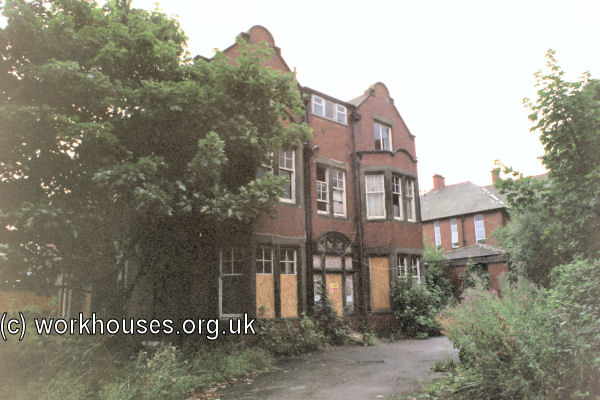
Hunslet workhouse nurses' home from the south-west, 2001. 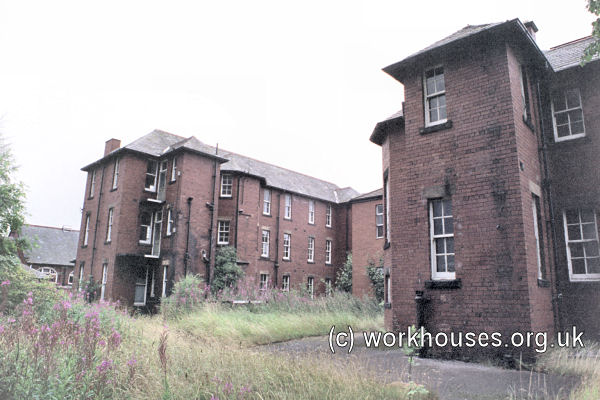
Former Hunslet workhouse infirmary blocks, Rothwell Haigh, from the north-west, 2001. The maternity block is in a convenient and quiet position between Infirmary and the main building. The lunacy block for thirty-six inmates consists of ample accommodation for male and female attendants in the centre, with epileptics on each side on the ground floor, and imbeciles above. The short-period lunatics are in one-storey buildings at each extreme end with wards and padded and attendants' rooms. The lunacy block is complete in itself, but is connected with Infirmary by covered way for administrative purposes. The Isolation Hospital is a complete building in itself and has its own nurses' accommodation, wash house, and mortuary. It is situated in a remote position on the south-east corner of the site. The aged married couples' cottages are on a high part of the site near Rothwell Haigh, entirely separate from the main buildings, and being next to the roadway will have pleasant gardens, with a light metal palisading fronting them. The elevations have been designed with little ornament, and what little there is, is chiefly concentrated on the administrative building, proportion being studied more than ornament for effect. The buildings are faced with Messrs. Armitage's (Robin Hood) bricks and stone dressings, and have Westmoreland green slated roofs. The corridors and wards in the main buildings have dadoes of salt-glazed bricks, whilst the kitchens and sanitary offices are of cream glazed bricks. The system of drainage is a simple one and on the most approved plan. No drains whatever are in the building. The heating and hot water supply is on the low pressure principle, steam being supplied to heat water in generators, two of which are placed under each block, one for heating and one for hot water supply. From these generators the water is circulated throughout the building both for warming and all domestic purposes, including baths and lavatories. Economy in running is the feature of the scheme, and, as far as available exhaust steam—which costs nothing—is utilized, and this effects a very considerable saving, as otherwise it would, in the ordinary course, go to atmosphere and be wasted, while live steam—which is paid for—would have to do the work it is now doing. Another and further saving is effected by returning into the boilers the condense water, which, already being at a high temperature, requires much less fuel to raise the steam pressure than if feeding from the cold. In addition, there is a saving of water and labour; also, the temperature being more equal, the life of the boilers is correspondingly increased. The buildings are lighted throughout by electricity. There are two combined compound engines, each of about 41 E.H.P., and 4-pole dynamos in the electric light station next to the boiler house, as well as a set of storage cells for supplying the lights from about 10-30 in the evening to about 6 o'clock next morning, and also for supplying the electricity for other purposes during the day time. The engines will be run in the evening and in the early morning so as to make use of the cells as little as possible. On the switchboard, in addition to the usual instruments and appliances, a meter is provided for measuring the consumption of electricity in the building. The cells are charged by means of a booster so that the dynamos are always run at constant pressure. There are about 1130 lamps in the building of various candle powers. The various blocks of buildings are supplied with current by means of lead covered and braided concentric underground cables, laid in brick troughs, run in with pitch, and protected by brick covers. All joints are made in cast iron boxes run in solid with bitumen. There are also two electrical lifts at the centre of each Infirmary pavilion, the cages being arranged to take a hand ambulance and two attendants. The usual operating rope used for starting and stopping the lift is dispensed with, the cage being controlled entirely by a simple switch, the lever of which is merely pulled in one direction or the other. The electric current is also used for working two fans in the kitchen block and for three motors, one driving the economiser, another the bakehouse machinery, and the other the automatic boiler stokers. There are nineteen telephones fixed in various parts of the building, all communicating with a central switchboard at the porter's lodge, the wires from block to block are encased in a lead sheathing, laid in tarred wood troughing, and run in with pitch. Spare underground wires are provided to allow of extensions in the future. The total cost of the buildings is approximately £85,850 or £182 per bed. When the substantial character of the buildings is taken into consideration, and it is remembered that not only is there no accommodation for children, which always brings down the average cost, but that a considerable portion of the accommodation is for Infirmary cases which always enhances the cost per bed, that the administration blocks are built in anticipation of future requirements, and that the figures given include not only the cost of erection, but also the purchase of land, the provision of a great quantity of new furniture, the expenses of raising loans, the labour-saving appliances in the kitchen and laundry, and the provision of a system of heating and electric light installation (in both of which the capital cost takes the place of recurring expenditure on fires and lighting) amounting altogether to £16,000, the cost will be found to be a very moderate one and to compare very favourably indeed with other similar institutions. |
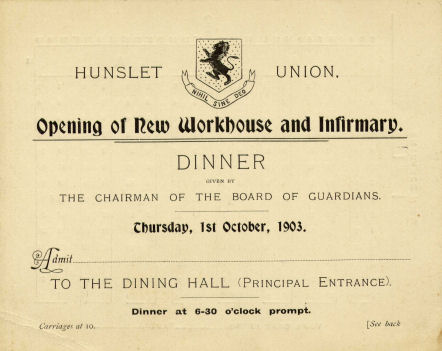
Hunslet new workhouse dinner ticket, 1903.
© Rothwell and District Historical Society.
In 1906, a foundation stone from the Rothwell parish workhouse was later incorporated into the wall of the new union workhouse.
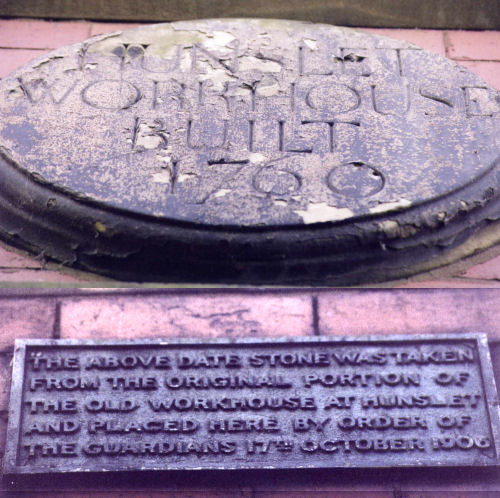
Rothwell parish workhouse foundation stone.
© Rothwell and District Historical Society.
The workhouse complex is shown on the 1905 map below:
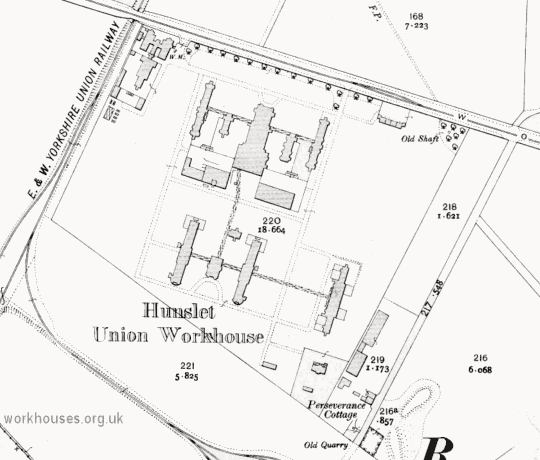
Hunslet workhouse site, 1905.
In 1925, Hunslet, together with Bramley and Holbeck, were absorbed by Leeds. The Hunslet site then became formally known as the Leeds Union Poor Law Institution at Rothwell Haigh and accommodated 430 inmates plus 39 vagrants. The tramp wards were closed in 1932. On 1st October 1934, the site became St George's Hospital under the control of Leeds Public Health Department and was used for the chronic sick until 1948.
The hospital finally closed in December 1991 and the site has been now completely redeveloped for housing.
Hunslet Cottage Homes
In 1896-7, the Hunslet Union erected a group of children's cottage homes on a four-acre site at the north side of Wood Lane at Rothwell. The official laying of the foundation stones took place on 16th March, 1896, and was accompanied by hymns and prayers led by the Vicar of Rothwell.
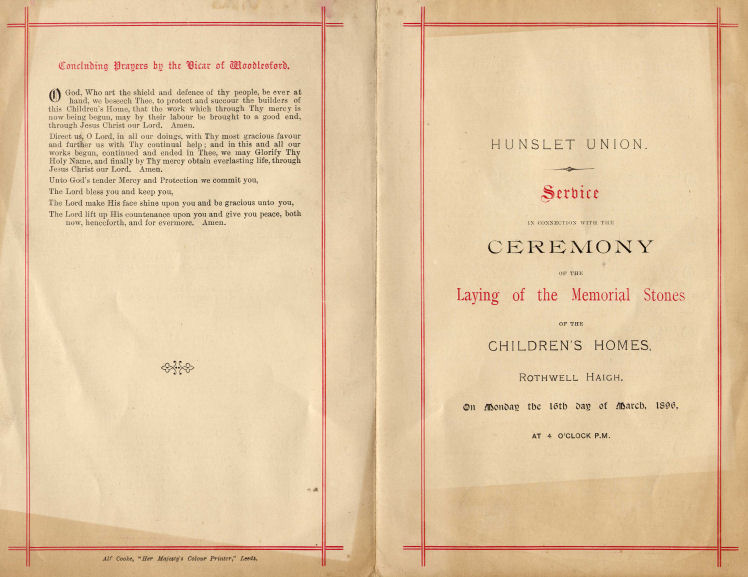
Hunslet cottage homes ceremony, 1896.
© Rothwell and District Historical Society.
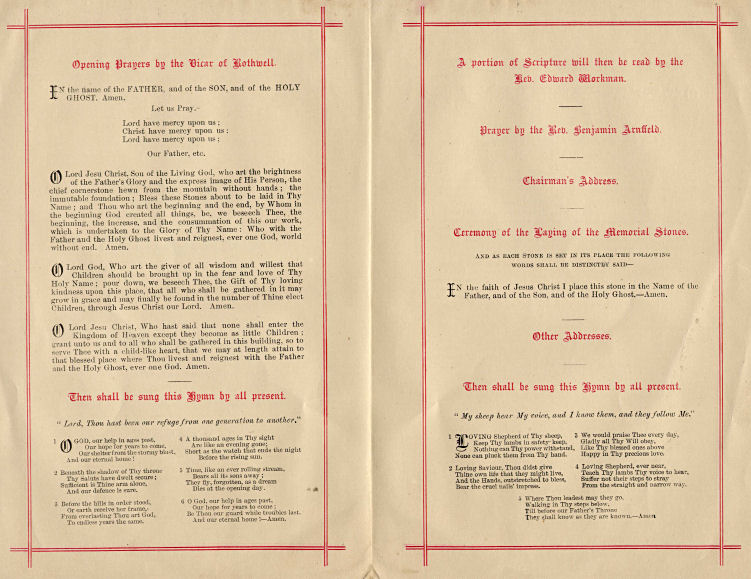
Hunslet cottage homes ceremony, 1896.
© Rothwell and District Historical Society.
The initial scheme of three homes, designed by Leeds architect EJ Dodgshun, was officially opened in July 1897 and cost £8,500. Each home contained a sitting-room for the foster-parents, a day-room, kitchen, and scullery on the ground floor, with four bedrooms above. Each home also had an isolation room. Two further homes were subsequently added. The five houses, each housing twenty children, were given the names Oak House, Beech House, Maple House, Hawthorn House and Chestnut House.
The location and layout of the homes is shown on the 1908 map below:
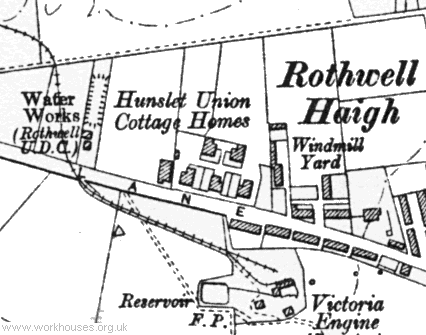
Hunslet cottage homes, 1908.
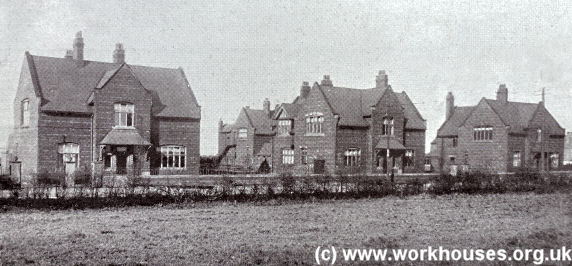
Hunslet cottage homes, c.1903.
© Peter Higginbotham.
In 1930, the running of the homes was taken over by the Leeds City Council's Public Assistance Committee. Following the 1948 Children Act, the site became the responsibility of the Council's Care of Children Committee. In 1949, Oak, Beech and Maple Homes were being used for boys, and Hawthorn and Chestnut for girls. Beech Home housed only Roman Catholic boys, while Roman Catholic girls occupied part of Chestnut House. By this date, conditions in the homes were far from satisfactory. The number of children living in each house was sometimes as many as 30. Playrooms were being used as dormitories, and dining-rooms were also serving as playrooms. A large recreation hut was being underused due to a shortage of staff. In three of the homes, the single bathroom contained two baths and four wash-basins, serving both children and staff. Most seriously, mining subsidence was beginning to cause cracks in the floors of the property.
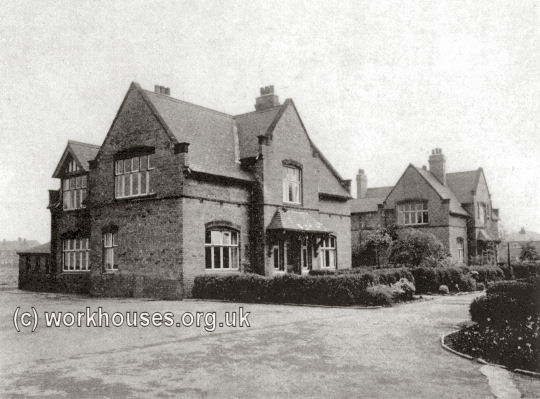
Hunslet cottage homes, 1950s.
© Peter Higginbotham.
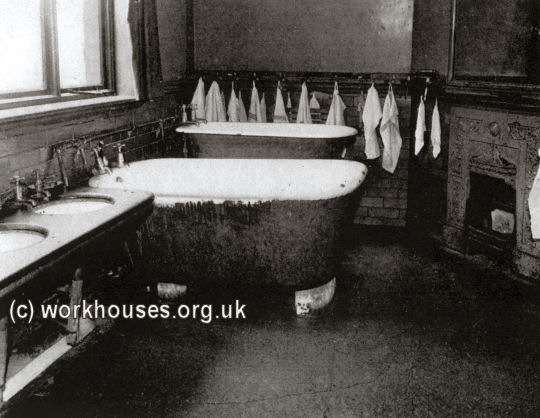
Hunslet cottage homes — Oak House bathroom, 1950s.
© Peter Higginbotham.
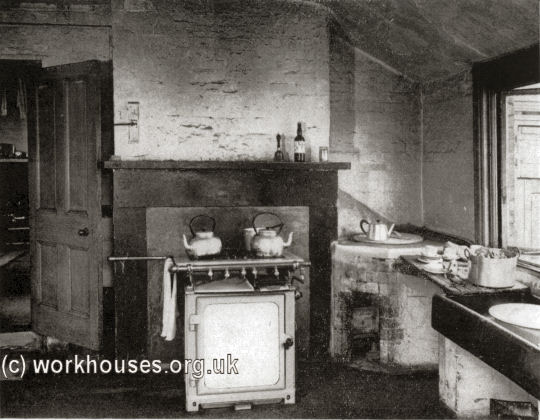
Hunslet cottage homes — Oak House kitchen, 1950s.
© Peter Higginbotham.
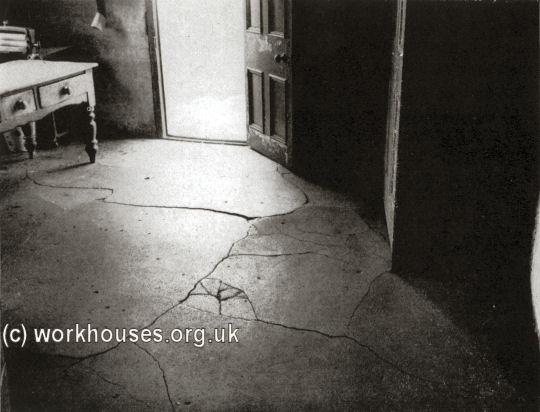
Hunslet cottage homes — effect of mining subsidence in Chestnut House, 1950s.
© Peter Higginbotham.
By 1956, all the cottage homes had been closed apart from one which continued in temporary use as a hostel for working boys until February, 1957. The site was then disposed of and the buildings demolished.
Staff
Inmates
Records
Note: many repositories impose a closure period of up to 100 years for records identifying individuals. Before travelling a long distance, always check that the records you want to consult will be available.
- West Yorkshire Archive Service (Leeds Office), Nepshaw Lane South, Morley, Leeds LS27 7JQ. Virtually no local records survive.
Bibliography
Links
- None.
Acknowledgment
- Thanks to Rothwell and District Historical Society for the souvenir programme and ticket and laundry picture.
Unless otherwise indicated, this page () is copyright Peter Higginbotham. Contents may not be reproduced without permission.


